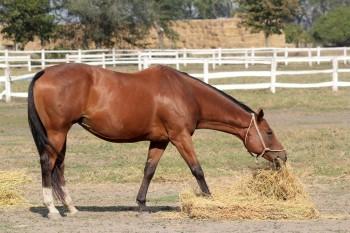
Kentucky Performance Products: Chew On This
Grazing, and therefore chewing, is an important part of your horse’s life. Kentucky Performance Products has the details!
In his natural state, your horse would spend 16 to 17 hours each day roaming around and grazing on a variety of plants. Biting, chewing and swallowing as he goes, there is a near constant flow of food into his digestive tract. When food is offered as meals, time spent chewing is often reduced, thus disrupting the natural rhythm of your horse’s digestive tract.
Digestion starts the moment a horse takes a bite of food. In the mouth, a full set of molars grinds foodstuff into small, easy-to-swallow pieces. Saliva released from salivary glands moistens the food, easing its passage down the esophagus and into the stomach. When a horse bolts his feed or has dental problems that impair chewing, food particles are not broken down and moistened sufficiently. Larger food particles are not well digested, reducing the amount of nutrients provided to the horse.
Saliva contains bicarbonate, which works to buffer the stomach acids that are produced continuously by the horse. When chewing is limited, gastric acid accumulating in an empty stomach can cause ulcers. The time spent chewing plays an important role in the both the health of the digestive tract and the proper absorption of nutrients.
The type of feed a horse eats greatly affects the time spent chewing. A horse takes about 40 minutes and chews between 3,500 and 4,500 times to consume a thin, two-pound flake of hay. On the other hand, two pounds of oats requires as few as 850 chews and can be consumed in about 10 minutes! Diets high in concentrates (grains/pellets) and low in forages reduce chewing time and disrupt healthy digestion.
The type of meals you feed affects chew time
Optimal time chewing: 16 to 17 hours per day
Meal: 18 lbs of hay (nine 2-lb flakes) and no concentrate
Estimated chew time: 360 minutes (6 hours)
When fed 2x per day = 12 hours of chewing
When fed 3 x per day = 18 hours of chewing
Meal: 14 lbs of hay (seven 2-lb flakes) and 2 lbs concentrate
Estimated chew time: 290 minutes (almost 5 hours)
When fed 2x per day = 9 3/4 hours of chewing
When fed 3x per day = 14.5 hours of chewing
Meal: 8 lbs hay (four 2-lb flakes) and 4 lbs concentrate
Estimated chew time: 180 minutes (3 hours)
When fed 2x per day = 6 hours of chewing
When fed 3x per day = 9 hours of chewing
When horses can’t graze full time, it is best to feed as much hay as possible and supplement with time-out on pasture whenever possible. Frequent small concentrate meals will more closely mimic how your horse would eat in his natural state. Feeding concentrates two, three or even four times per day will help keep your horse’s digestive tract healthy.
If your horse is an easy keeper, choose a mature grass hay so you can feed more of it. It will provide fiber and chew time without contributing too many calories. When your horse is required to spend periods of time with an empty stomach, supplement with Neigh-Lox® or Neigh-Lox® Advanced to buffer stomach acid and coat sensitive mucosa.
Article written by KPP staff.
Copyright (C) 2015 Kentucky Performance Products, LLC. All rights reserved.
About Kentucky Performance Products:
ProbioticWise
Need to sustain a healthy hindgut?
Ask your vet about ProbioticWise™.
ProbioticWise:
- Maintains the healthy population of beneficial bacteria throughout the GI tract
- Supports the restoration of normal GI tract function in horses challenged by diarrhea
- Supports complete digestion of starch and sugar in the foregut, lowering the risk of hindgut upset and pH imbalances (acidosis) that can lead to colic and laminitis
- Supports reduced inflammation levels in GI tract tissues
- Supplies nutrients to the gastrointestinal tissues that support the healing of stomach and colonic ulceration
- Supplies polyphenols, nucleotides, and polysterols—antioxidants that contribute to the maintenance of healthy intestinal cell membrane function
For more information, visit KPPvet.com.







Leave a Comment